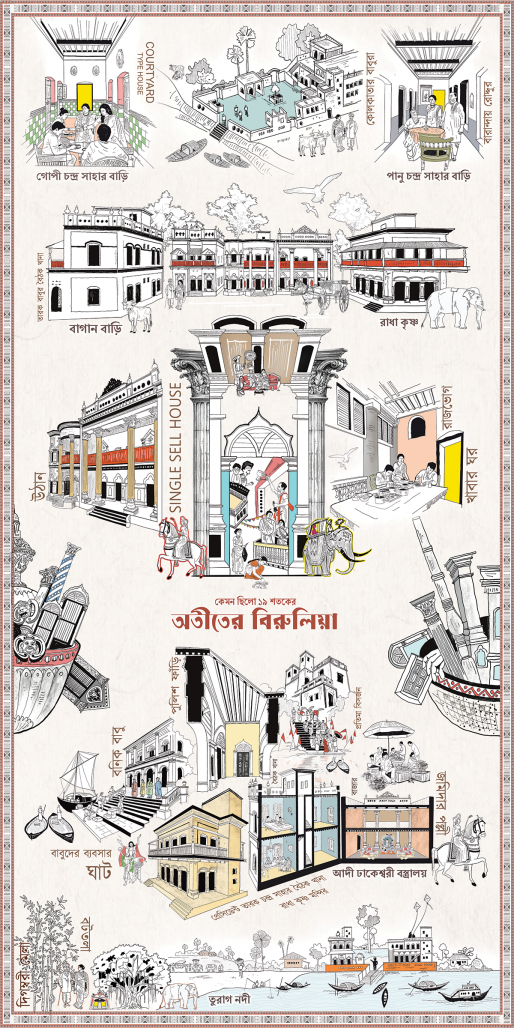Bangladesh is rich in its unique culture and heritage, renowned for its strategic geographic location and a wide range of architectural styles spanning from ancient to modern periods. Despite this richness, the country continues to lag behind in terms of heritage conservation and pride in its historical assets. The Department of Archaeology (DOA), established in 1972 under the Ministry of Cultural Affairs, is the primary government body responsible for the conservation, preservation, and excavation of tangible heritage across the country. Although it is estimated that there are over 5,000 heritage buildings and sites in Bangladesh, many of them remain undocumented, unexplored, and unprotected. As of 2019, the DOA has identified 938 sites through surveys in only 20 districts, with just 518 of them listed as protected monuments. This leaves over 3,700 sites unprotected and in a state of neglect. One such example is Birulia, a historically significant yet overlooked settlement on the outskirts of Dhaka. Dating back to the late 18th century, Birulia was once a thriving business center, an important river port, and a sacred place for the Hindu community during the reign of the Bhawal kings. It stands today as a silent witness to the rise of the middle-class merchant elite and deserves attention for its conservation and recognition.
Historical Background:
Bangladesh has a rich architectural heritage shaped by socio-cultural, political, and climatic influences, including Hindu, Muslim, and British colonial periods. During British rule, especially after the Permanent Settlement Act of 1793, a new merchant class emerged and settled around Dhaka, using nearby rivers for trade. Birulia, located on the west bank of the Turag River, became a significant merchant settlement and sacred Hindu site under the Bhawal Zamindars. At its peak, Birulia had around 64 colonial-style buildings, including homes, temples, and vibrant marketplaces.
The Saha family, including the owners of Adi Dhakeshwari Bostraloy, were prominent residents and built courtyard houses along a 1 km long road called Tarok Babur Rasta made by Tarok Chandra Saha ( former president in Birulia ) constructed in 1914. After the 1947 partition, riot of 1964 and the 1971 Liberation War, most Hindu families left, and many buildings were abandoned or demolished. Today, only 10–12 historic structures remain. Despite its decline, Birulia comes alive during festivals like Durga Puja and Pahela Baishakh. There are centennial banyan trees under which a famous fair, known as Digambari Mela, is held every year. Surrounded by rapid urbanization, the site urgently needs conservation to protect its cultural and architectural legacy.
Design Decision Process:
As a heritage site, the first step is to interview the local people and document all tangible and intangible heritage elements. This process revealed three core issues:
1. Poor Heritage Management – due to a lack of awareness and rising communalism.
2. No Provision for Economic Development – limited opportunities for local growth.
3. Poor Trail Route and Lack of Tourist Facilities – inadequate infrastructure for visitors.
These issues stem from a central research question:
"In the context of rapid urbanization and land scarcity, how can heritage sites be conserved by respecting their originality and significance while accommodating the contemporary needs of society?"
Understanding these challenges, the people of Birulia and I defined a shared aim:
To uplift the community and enhance urban living environments through the conservation and restoration of its historical and architectural heritage.
To address the core issues, we proposed three targeted solutions:
• Community Co-Creation for improving heritage management
• Neighborhood Upliftment for fostering economic development
• Cultural Sustainability for enhancing trail routes and tourist facilities
To ensure effective implementation, we follow the 3D Rule: Discuss, Detect, and Decision.
MASTER PLAN :
For the master plan, the site has been divided into three main zones:
1. Educational Zone
2. Heritage Zone
3. Commercial Zone
1. Educational Zone
This zone is defined based on the existing functional structures, which include a school, a mosque, a ghat, and a heritage building. Additionally, a police station currently operates within a heritage structure. Considering these active civic and institutional uses, this area has been designated as the Educational Zone.
2. Heritage Zone
This zone consists of a cluster of six heritage buildings. Based on community feedback and references from successful heritage conservation case studies, this cluster is proposed to be transformed into a Heritage Guest House Complex, promoting adaptive reuse and sustainable tourism.
3. Commercial Zone
A new substation is currently under construction in this area, which obstructs the site’s visibility and accessibility from the main road. Local residents expressed their dissatisfaction with the substation being a dominant element in the neighborhood. As a response, the commercial zone is planned in this area by relocating the substation, landfilling the site, and creating a strong access route connecting the main road with the heritage trail.
Facilities in this zone include a market, museum, conservation center, and restaurant, along with essential services such as a medical center, police station, and public amenities for the local community.
Access Points - The site will have two main entry points:
• One from the main road
• Another from the Turag River, enhancing both land and water connectivity
2025
Site Location - Birulia , Savar , Dhaka , Bangladesh.
Site Area - 7 Acre
Project Type - Heritage Conservation
RESEARCH QUESTION - "In the context of rapid urbanization and land scarcity, how can heritage sites be conserved by respecting their originality and significance while accommodating the contemporary needs of society?"
Tangible Heritage – 13 Building, 5 Temple
Intangible Heritage – 3 Trees, Digambari Mela
Decision Making Process - Pivotal Decision Making Through Heritage Based Consensus. Follow the three step
Discuss - Detect - Decision
Intervention Area - 3 Zone
Educational Zone - How to design a new structure in a heritage compound?
Commertial Zone - Totally new development by respecting the site.
Heritage zone - How to honour the heritage itself?
Design: Md Shazzadul Islam
Supervisor: Z H M Monjur Murshed











